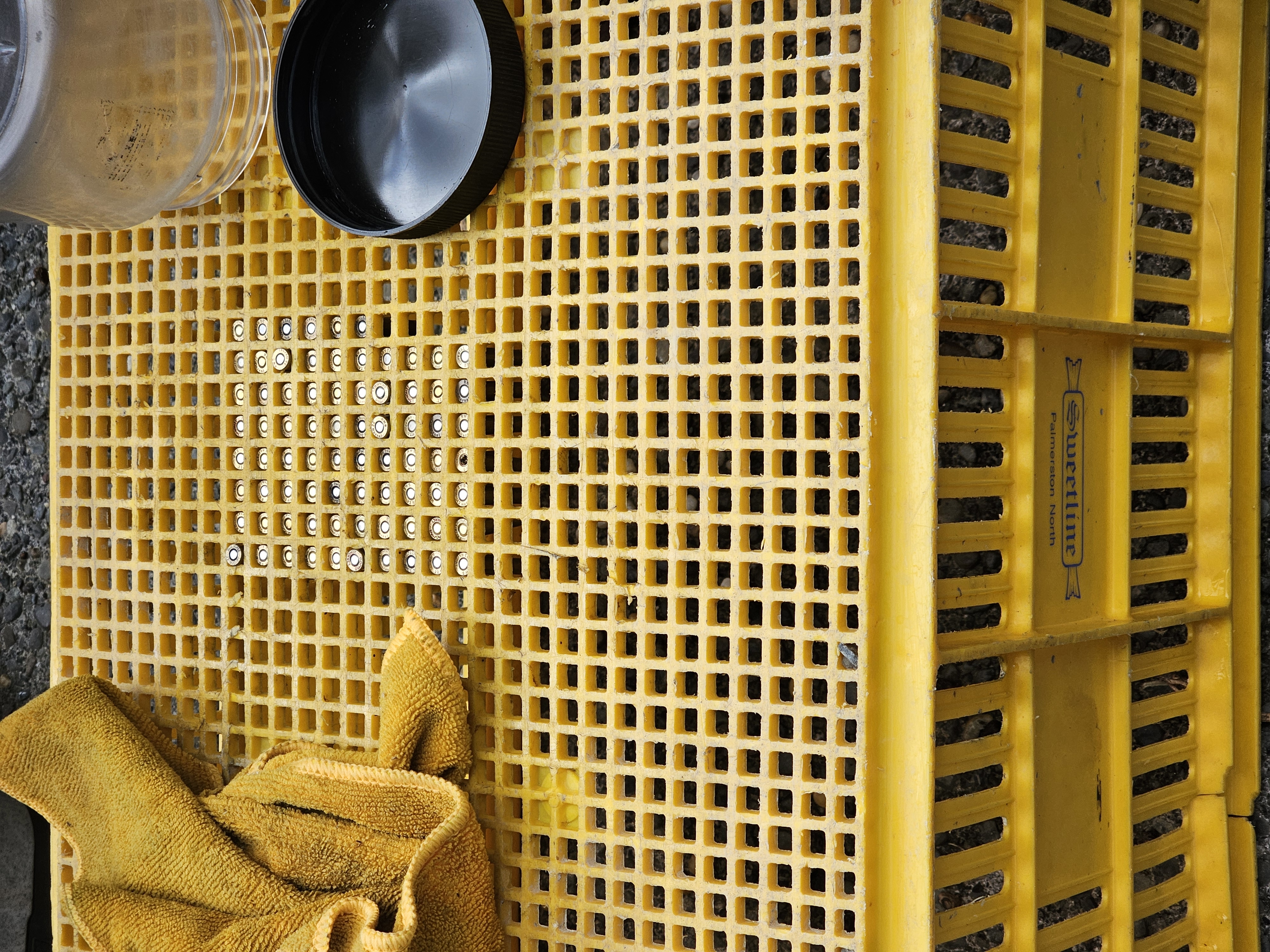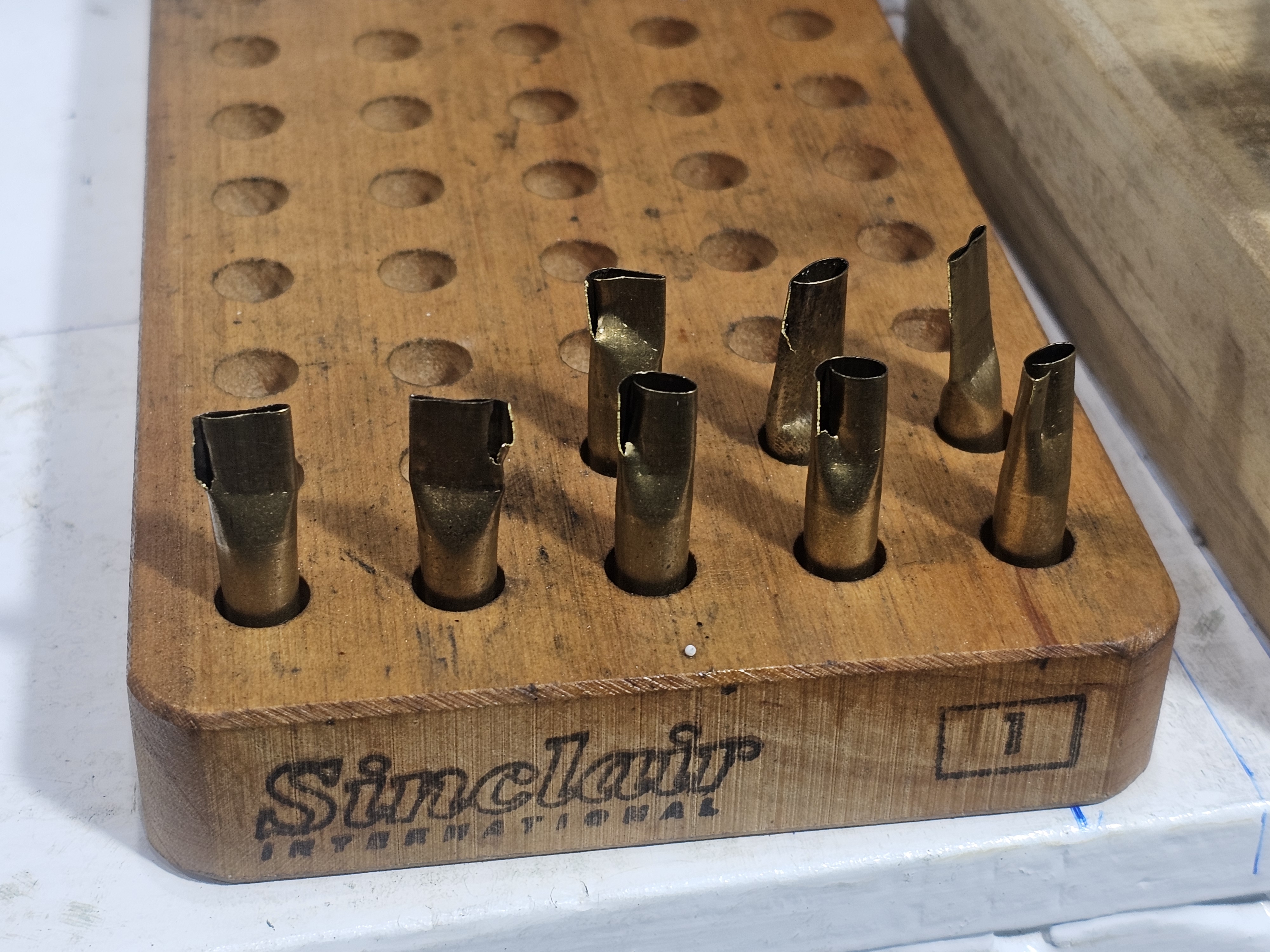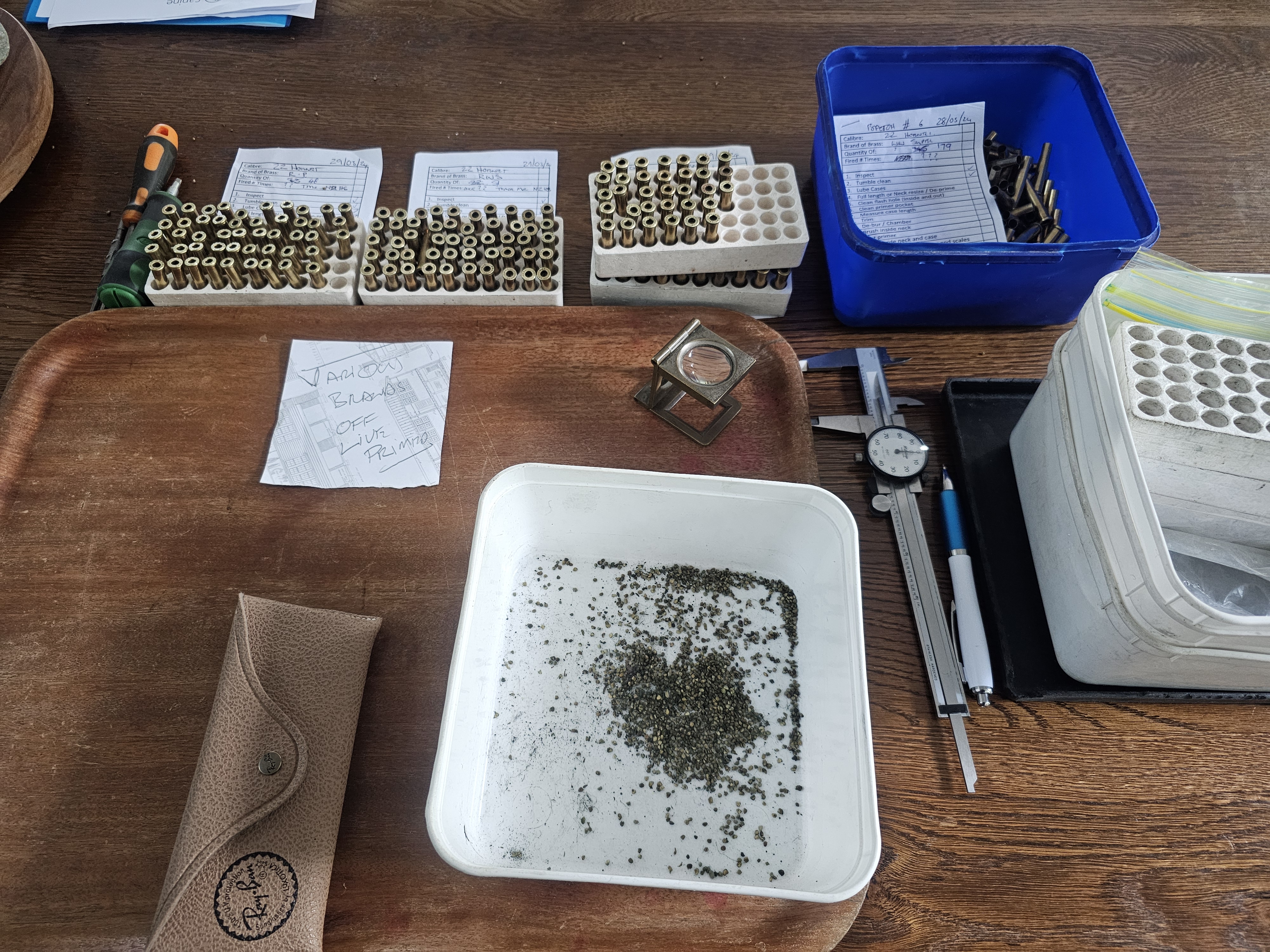Welcome guest, is this your first visit? Create Account now to join.
Welcome to the NZ Hunting and Shooting Forums.
Search Forums
User Tag List
+ Reply to Thread
Results 16 to 30 of 37
-
30-03-2024, 08:29 AM #16Member

- Join Date
- Sep 2013
- Location
- Wairarapa
- Posts
- 1,422
-
-
30-03-2024, 09:17 AM #17Member

- Join Date
- Mar 2012
- Location
- South Waikato
- Posts
- 8,545
I would pull the projectiles. Dump the powder then use the primed cases for a safe known load.
Overkill is still dead.
-
30-03-2024, 09:25 AM #18Banned

- Join Date
- May 2022
- Location
- Ngaio, Wellington
- Posts
- 568
A couple of reasons for not firing them, all based are caution and not damaging my rifle or my beautiful face!
Firstly I'm working at my work bench and want a quick, safe result. I don't want to fire 60 rounds of Hornet I my basement for fear of sparking an AO callout and being the next headline in Stuff, "REGISTERED FIREARMS OWNER LOOSES LICENCE FOR WRECKLESS DISCHARGE!" Which leaves the only option being, drive to a farm or range, fire 60 rounds, then drive home! WOFT!
Having pulled the projectiles I now know the powder charges varied from 9.2grn, which is below most recommended minimums, too 12.2 grains which is above maximum and probably a compressed load. Likely outcome of firing those would be a split case jammed in the breech, popped primer with associated pitting damage to the bolt face.
I have taken the advice of more experienced Forum members too try and kill the primer by soaking them.
Caution first with all things gun!
-
30-03-2024, 10:08 AM #19Member

- Join Date
- Aug 2017
- Location
- King Country
- Posts
- 2,465
-
30-03-2024, 10:17 AM #20
Fire off the primers with barrel end in a suppressor and old blanket maybe.dont poke bare barrel into your good polar fleece coat....result looks like ciggy burns.the coke bottle idea sounds( or no sound?)like a goer.
75/15/10 black powder matters
-
30-03-2024, 10:27 AM #21Banned

- Join Date
- Mar 2024
- Location
- west coast N I
- Posts
- 625
My plan B - since plan A didnt seem to meet much approval - would be , decap them in your loading press. At least , being Hornet , they should all be boxer primed so no issues popping the primers out and discarding.
Not sure on dropping them in the ocean - the sea isnt a dump for all to use. Drop them in an offal hole or soak in acetone then discard in your usual rubbish disposal.
-
30-03-2024, 11:00 AM #22Member

- Join Date
- Sep 2013
- Location
- Wairarapa
- Posts
- 1,422
Apart from ears and eyes, the main precaution I take when decapping live primers is to put them back into a packet that is well labelled so I or anyone else knows they are unknowns.
I also try to make sure that there are lots of different types in the same packet, just in case I miss the label, the mixture of colours and sizes should be a red flag.
It isn't a good idea to store live primers together and loose as it can cause a chain reaction.
As others have said, just decapp them live, eyes and ears and gentle, if one does go off, its not much different to a cap gun. At worst your cat might decide to leave the room.
-
30-03-2024, 03:27 PM #23Member

- Join Date
- Dec 2021
- Location
- Tauranga
- Posts
- 6,008
Correct, although acetone is a reactive in and of itself. I'd be a little screwy about applying a reactive chemical to something that reacts like a primer just because of the potential... Unlikely to cause an explosive reaction, but from my experience in mining ...odd - things can happen when you start mixing different reactive chemicals without care. Used to have massive fun in the emulsions plant with suppliers changing precursor specs without telling us and finding out on the first batch with the new supply. That was usually a lengthy phone call to the head chemist for a WTF just happened explanation while we tried to identify what had changed!
One thing I will point out with soaking primers is we have absolutely no idea what environmental protection the manufacturer applied to the surface of the primer inside the cup. I suspect the reason I had no success when I tried soaking them is that I didn't disturb the surface of the priming compound inside the primer cup and that the liquids I applied to the primers just sat on top of a coating on the priming compound in the cup.
-
30-03-2024, 10:07 PM #24Member

- Join Date
- Nov 2021
- Location
- Waikouaiti
- Posts
- 642
It's really not that big a deal. Just shoot them with muzzle in a plastic bottle. Or press the muzzle into some polystyrene and shoot them. Very uncomplicated thing to solve.
Or just press them out and reuse them.
-
30-03-2024, 10:25 PM #25Member

- Join Date
- Mar 2012
- Location
- South Waikato
- Posts
- 8,545
-
31-03-2024, 09:47 AM #26Banned

- Join Date
- May 2022
- Location
- Ngaio, Wellington
- Posts
- 568
REPORTING BACK - PROCESS - OUTCOMES
Thanks Team for your opinions and advice which varied from:
- Kill the primers by drowning them
- Just run the primed case through the press - no worries
- Pull the projectiles and reuse the primed cases (with known load, but unknown primer)
- Fire the live rounds
- Fire or hammer discharge the primers
- KISS and don't over think it
I have only been reloading for 8 - 10 months and am enjoying the learning. I operate on the basis that, "The only dumb question is the one you didn't ask!" I'm not that risk averse, but do adopt a safe, precautionary approach to unfamiliar things.
Thanks everyone for your advice. After consideration I adopted the, "kill them by drowning method;"
- First submerged them over night in 15w40 engine oil
- In the morning I drained the engine oil off and soaked them in white spirits to remove the oil
- Then I soaked the them in acetone
- Then I flushed them with HOT tap water, and soaked them in hot soapy water
("Over kill is under rated!)
After they had drained and dried in the sun (and patented yellow shell holder), I fired 10 cases on my Weihrauch and got ZERO ignitions. Then I ran them through the depriming press, again with ZERO ignitions out of 70 cases. Then tumbled them and finally sorted them by brand.
Interesting to notice that, despite the number of times I cleaned them to remove the oil, the walnut still attracted and accumulated in trace oil inside the cases and primer pocket, forming a gluggy lump, which was easily removed with a scribe, but still another task....
I'm happy with both my anal retentive process and the outcomes.
I'm especially pleased that I didn't fire the live rounds because, on inspection, eight cases were split for the mouth to the shoulder. This highlights the pitfall of buying "Once Fired" brass through TradeMe. Based on the variations of powder charge, projectiles and inked hierographics on the outsides of the cases, I would say some of the these cases had been loader several times, some to maximum or compressed loads, in the quest for the highest possible velocity. I don't really understand the obsession some shooters have with "Maximum velocity!!??? I tend to load minimal powder charges to achieve efficient, accurate, killing rounds, so as to prolong brass life/usage, minimise noise, recoil, wear and tear. After all, "Dead is dead," and the target species doesn't know or care whether the projectile is doing 2400 ftps or 3100 ftps......
Thanks all for advice, I'm moving on to sizing next.


-
31-03-2024, 10:22 AM #27Member

- Join Date
- Dec 2021
- Location
- Tauranga
- Posts
- 6,008
Ok, if you've oiled the inside of the cases you need to double damn make sure there isn't any oil residue left and I mean double damn make sure. Reason for that is oil traces can do funny things to the coating chemicals used on the powders to retard the burn and slow the rate at which the pressure increases when you pull the trigger, by soaking into the coatings and altering the retardant affect. Also the oil can act as a fuel source in a really hot burn. If the walnut was sticking into the cases in a glug, that's way too much oil residue for my comfort factor...
-
31-03-2024, 10:22 AM #28
I definately would have pushed the live primers out in the press using a decaping die, I have done it with no issues and they push out easy. Once done its just the easy normal routine without worring about having to remove all that oily stuff you put in your cases to kill the primers.
I guess you did it your way for your own safety and piece of mind so congrats for thinking about your safety, I just hope all that oily stuff is 100% out of your shells so you don't have trouble with your powder going all gluggy etc.
Anyway glad you got the job done When hunting think safety first
When hunting think safety first
-
31-03-2024, 10:40 AM #29Member

- Join Date
- Sep 2013
- Location
- Wairarapa
- Posts
- 1,422
I haven't looked at second hand brass on TM for a few years now, but when I used to, for some reason, everytime you see brass advertised on TM, it is almost always 'once fired' even on multiple different listings from different sellers where the photos show three different types of primers. Partly why I stopped shopping in that particular category.
@Hugh Shields, I am happy to put your brass through my ultrasonic cleaner if you think that would be helpful with the oil. Unless someone in Wellington chimes in with a similar offer, feel free to PM me and we can figure out a way to get the brass here.
-
31-03-2024, 11:00 AM #30Member

- Join Date
- Aug 2023
- Location
- WA
- Posts
- 694
The pitfalls of trying to save money... If I didnt reload it, i don't fire it.
For the amount of firings u can get out of it, buy qaulity new brass. You'll save it in 2 firings, knowing u can trust your brass.
Similar Threads
-
Guys, please adivise...re discharging a firearm...
By EeeBees in forum ShootingReplies: 40Last Post: 27-12-2016, 08:22 AM -
Fave new method
By Pengy in forum Game Cooking and RecipesReplies: 2Last Post: 30-10-2016, 02:12 PM -
Downwards or Safest Direction
By 7mmMauser in forum Firearm SafetyReplies: 49Last Post: 18-03-2015, 01:11 PM -
Field Dressing gutting method
By Kumoe in forum Varminting and Small Game HuntingReplies: 5Last Post: 25-02-2015, 03:08 PM -
Carrying Water . . . . . what's your prefered method?
By The Rifleman in forum Gear and EquipmentReplies: 25Last Post: 10-07-2013, 10:31 AM
Tags for this Thread
Welcome to NZ Hunting and Shooting Forums! We see you're new here, or arn't logged in. Create an account, and Login for full access including our FREE BUY and SELL section Register NOW!!





 36Likes
36Likes LinkBack URL
LinkBack URL About LinkBacks
About LinkBacks




 Reply With Quote
Reply With Quote


Bookmarks